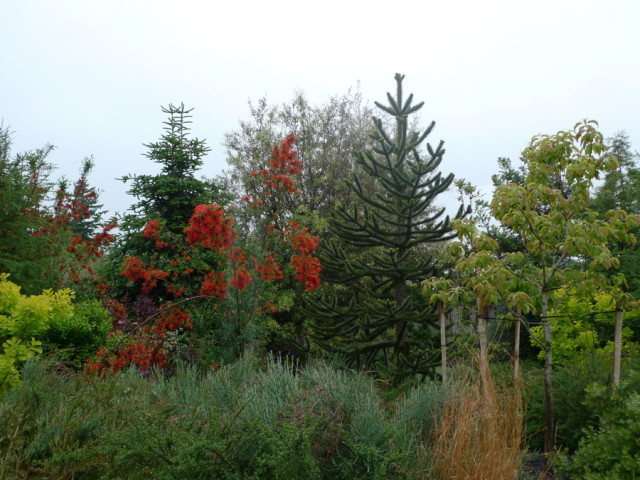Chilean flame tree (Embothrium coccineum)

A clump of Chilean flame trees graces the southern hemisphere planting at the soaking pool at the McMenamin’s Edgefield Manor.
Yesterday I passed the Kennedy School on NE 33rd Avenue and Jessup and noticed that the Chilean flame tree (Embothrium coccineum) has begun flowering.
This wildly spectacular tree from has bright orange, firecracker-like flowers that appear seemingly from nowhere in late May-early June. Embothrium coccineum surely must qualify as the most dramatic flowering tree that can be grown in the Willamette Valley.
Kimberley Kinkaid, Head Gardener at Edgefield Manor, lists this plant as one of her favorites in this article I wrote featuring the talented professional gardeners behind three of the larger McMenamins gardens.
If you want to see these trees in their full flowering glory, the next week or two is your moment.
At Edgefield Manor, there is a fantastic clump of Embothrium planted around the soaking pool at the Ruby Spa. Stay overnight at the hotel and you can soak with a cocktail in hand, admiring the flame trees to your hearts’ content.
The Kennedy School also has two trees: one ingeniously planted directly behind the sign on the northwest corner of the site and one a few yards to the east, along the north property line. Both trees are well-sited, and are doing well so far – obviously Kennedy School’s Head Gardener Erich Petschke positioned the trees with care.
I don’t think Cornelius Pass Roadhouse Head Gardener Nicky Love has planted any there yet – it’s a more old-fashioned and wild garden there – but who knows, she might!
Embothrium coccineum can reach 30-40 feet, although I haven’t seen any attain anything near that size in the Portland area yet. It tends to do well on the southern Oregon coast and into California. The species is native to cool, mountainous areas of central Argentina and Chile, from high elevations of the Andes down to sea level. Since its native climate is cool and moderate, it can perish in our brief but sometimes brutal hot summers, unless sited where its roots can stay cool. A particularly cold winter can also cause damage so it’s a good tree to site away from harsh winter winds.
It is reputed to be a bit fussy to get going but if you have the right conditions and follow a few simple rules, it can certainly be grown here. For more detailed cultural information, check Sean Hogan’s excellent book, Trees for All Seasons (Timber Press).
Tips for growing the amazing Chilean flame tree (Embothrium coccineum):
1. Plant tree with roots shaded and tops in sun. Best is if the sun is blocked by other plants, ground covers or woody mulch.
2. Plant tree in lean soil rather than rich, amended, composty soil.
3. Plant tree in well-draining soil – a slight slope to the north or east is ideal.
4. Avoid fertilizing, particularly with any fertilizer containing phosphorus or potassium, which can kill Embothrium.
5. Avoid watering during warm weather. (This can be a challenge with a new young tree but you just have to be careful – try to water a young tree before a heat wave, or in the cool of the night. And avoid the problem by planting early in spring, or in the autumn, so the tree roots in during cool weather.)
Find the right spot in your garden – and humor the tree a bit by not fertilizing and watering with care – and you can enjoy the wild orange flowers of this spectacular tree in your own little paradise.
Meantime, go take a peek at the trees at the Kennedy School and Edgefield Manor and see what you think. While you’re there, keep an eye out for these professional gardeners whose skill and dedication makes these gardens so special.
